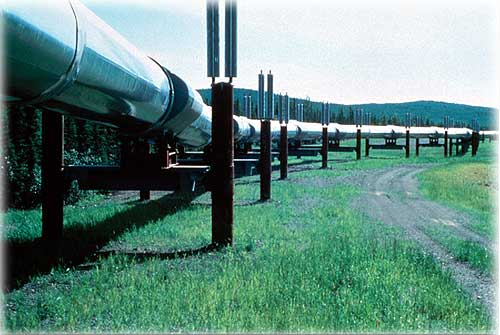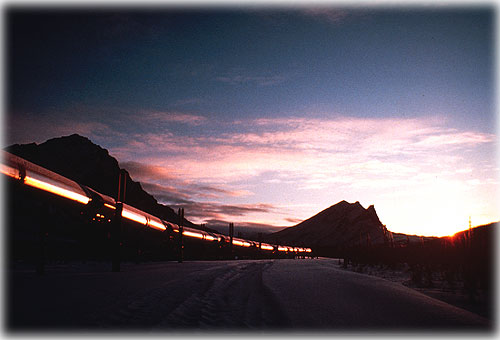 The pipe that changed Alaska
The pipe that changed Alaska
By Ned Rozell
July 04, 2007
Wednesday
Thirty years ago, about 100 miles south of the Arctic Ocean,
a welder fused a section of 48-inch pipe with molten metal. When
he snuffed his torch, the trans-Alaska pipeline was an 800-mile
tube of steel.
On June 20, 1977, oil began flowing from the bowels of the earth
at Prudhoe Bay, through Pump Station 1, and into the trans-Alaska
pipeline. At the time, an editorial in the Fairbanks Daily News-Miner
heralded the pipeline as the world's largest private construction
project. Others had grander analogies, comparing the pipeline
to the Egyptian pyramids and the Great Wall of China.
More than 28,000 Alyeska Pipeline Service Company workers and
contractors worked on the pipeline at the peak of activity in
1975, and 31 people died in activities related to pipeline construction,
according to Alyeska Pipeline Service Company.
 More than 28,000 Alyeska
Pipeline Service Company workers and contractors
More than 28,000 Alyeska
Pipeline Service Company workers and contractors
worked on the pipeline at the peak of activity in 1975, and 31
people died
in activities related to pipeline construction, according to
Alyeska
Pipeline Service Company.
Photo courtesy Alaska Division of Community and Business Development
The pipeline almost wasn't built. After ARCO and Humble Oil and
Refining Co. (now Exxon) announced the Prudhoe Bay discovery
well in March 1968, environmentalists voiced their concerns:
aside from being an absurd idea, a pipeline snaking the length
of the largest state in the union could endanger its people,
animals, plants and waters. In April 1970, the Wilderness Society,
Friends of the Earth and the Environmental Defense Fund sued
then Secretary of the Interior Walter Hickel to stop the pipeline
from happening.
After three years of passionate arguments between environmentalists
and pipeline backers, world events tipped the balance toward
the construction of the pipeline when Egypt and Syria invaded
Israel on Oct. 6, 1973. To retaliate for American military aid
to Israel, Arab members of OPEC stopped exporting oil to the
U.S.
The Trans-Alaska Pipeline Authorization Act became law after
it passed in both the House of Representatives and the Senate
on Nov. 16, 1973. Alyeska Pipeline Service Company, then comprised
of BP, ARCO, Exxon, Mobil, Amerada Hess, Phillips Alaska, and
Unocal, started construction of the pipeline began the next spring.
 Originally budgeted
at $900 million, the trans-Alaska pipeline cost more
Originally budgeted
at $900 million, the trans-Alaska pipeline cost more
than $8 billion to build.
Photo courtesy Alaska Division of Community and Business Development
Japanese steel mills shipped more than 100,000 lengths of 40-
and 60-foot pipe. Welders in Valdez and Fairbanks then made 42,000
double joints, connecting two sections of pipe together, before
the longer sections were trucked to the field. On March 27, 1975,
the first piece of pipe was set in place at the Tonsina River
between Valdez and Copper Center. A little more than two years
and 66,000 field welds later, the pipeline was the solid sum
of its parts.
Today, the pipeline spans a little more than 800 miles from Prudhoe
Bay to Valdez. More than half of the pipe, 420 miles, was routed
above the ground so the warm pipe wouldn't melt permafrost. Four
miles of pipe are refrigerated below the ground, and, in 376
miles of thaw-stable and non-permafrost areas, the pipe is buried.
The pipe dives under or crosses over 834 rivers and streams.
Workers constructed 13 bridges along the route, including a $30
million, 2,295-foot orthotropic box girder model over the Yukon
River.
Originally budgeted at $900 million, the pipeline cost more than
$8 billion to build. Royalties from North Slope oil provide
more than two-thirds of Alaska's state budget, which has swelled
considerably since oil started to flow on June 20, 1977, a day
the editorial writer at the Fairbanks Daily News-Miner marked
with the following words:
"As the first oil enters the trans-Alaska pipeline, we stand
at the point of reaping benefits which can make Alaska the showplace
of modern development. We can nurture our wealth to give Alaska
a stable economy and keep the quality of life we have enjoyed
in the past, or we can squander it in ways which may someday
make 'Alaska' a word synonymous with foolishness and greed."
This column is provided
as a public service by the Geophysical
Institute,
University of Alaska Fairbanks, in cooperation with the UAF
research
community. Ned Rozell [nrozell@gi.alaska.edu
] is a science writer at the institute.
E-mail your news &
photos to editor@sitnews.us
Publish A Letter on SitNews Read Letters/Opinions
Contact the Editor
SitNews
©2007
Stories In The News
Ketchikan, Alaska
|


